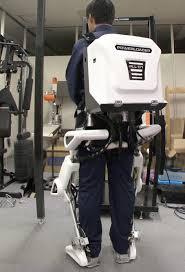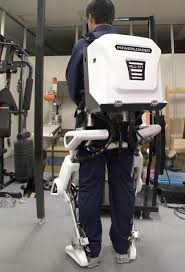Technology's Answer to Heavy Manual and Repetative Jobs

This high-tech suit might not have the features of the Tony Stark in the film series ‘Iron Man’, but it certainly has the ability to enhance the natural abilities. Exoskeleton suits are slowly but surely gaining a foothold in the real world.
Many companies are not resorting to the use of exoskeleton in limited ways to help workers with heavy work as well as assist in repetitive work.
In order to help workers lift and carry objects more easily and with less risk of injury, the Japanese company Panasonic had recently announced the commercial production and sale of an exoskeleton suit designed.
The suit, developed in collaboration with a subsidiary company called ActiveLink, weighs a little more than 13 pounds and is built to protect the back, thighs, and feet of workers. The suit provides certain sturdiness to the workers enabling them to carry upto 33 pounds of extra load. The relatively light weight of the metal exoskeleton enables workers to move around with relative ease.
After an initial testing among the warehouse handlers in Osaka in Japan, the device currently is being undergoing a second trial with the forestry workers in the region.
At present a limited types and number of such high tech exoskeletons are available commercially and have primarily been tested in medical and military settings. However in recent years, technology is driving the use of these devices in other fields. The makers of these devices say that these would help in creating a difference for many manual laborers, especially as the workforce ages.
“We expect that exoskeletons, or power-assist suits, will be widely used in people’s lives in 15 years,” Panasonic spokesperson Mio Yamanaka said.
Tasks that require physical strength, such as moving things and making deliveries, public works, construction, agriculture and forestry are best suited for the use of this device, says Yamanaka.
Built of lightweight carbon-fiber and motor, the suit becomes active when a worker, wearing the suit, lifts or carries a load as sensors activate the motor. Company sources said that they are testing another model that would be able to lift loads that weighs upto 220 pounds.
To assist their workers to efficiently do the repetitive tasks, the German carmaker BMW has, in collaboration with ergonomics researchers at the Technical University of Munich, have developed a custom-made, 3-D-printed orthotic device that is worn on the thumb of the by the workers.
Audi is conducting tests for another wearable device that would act as a back support for workers engaged in repetitive task such in a crouching position as on the assembly line.
Exoskeletons used in medical technology, like the one sold commercially by Japanese company Cyberdyne, makes use of nerve signals to detect a wearer’s intention to move before the wearer of the device actually applies assistive force. Now the company has signed up w2iht a automotive company to develop such assistive exoskeleton devices for use the in the factories.
Rehabilitation of injured persons as walking aids is one of the major areas where exoskeletons are used commercially. To assist people with spinal cord injuries, a company called ReWalk, based in Marlborough, Massachusetts, recently announced the commercial production of its latest version of the device.
(Source: http://www.technologyreview.com)
Many companies are not resorting to the use of exoskeleton in limited ways to help workers with heavy work as well as assist in repetitive work.
In order to help workers lift and carry objects more easily and with less risk of injury, the Japanese company Panasonic had recently announced the commercial production and sale of an exoskeleton suit designed.
The suit, developed in collaboration with a subsidiary company called ActiveLink, weighs a little more than 13 pounds and is built to protect the back, thighs, and feet of workers. The suit provides certain sturdiness to the workers enabling them to carry upto 33 pounds of extra load. The relatively light weight of the metal exoskeleton enables workers to move around with relative ease.
After an initial testing among the warehouse handlers in Osaka in Japan, the device currently is being undergoing a second trial with the forestry workers in the region.
At present a limited types and number of such high tech exoskeletons are available commercially and have primarily been tested in medical and military settings. However in recent years, technology is driving the use of these devices in other fields. The makers of these devices say that these would help in creating a difference for many manual laborers, especially as the workforce ages.
“We expect that exoskeletons, or power-assist suits, will be widely used in people’s lives in 15 years,” Panasonic spokesperson Mio Yamanaka said.
Tasks that require physical strength, such as moving things and making deliveries, public works, construction, agriculture and forestry are best suited for the use of this device, says Yamanaka.
Built of lightweight carbon-fiber and motor, the suit becomes active when a worker, wearing the suit, lifts or carries a load as sensors activate the motor. Company sources said that they are testing another model that would be able to lift loads that weighs upto 220 pounds.
To assist their workers to efficiently do the repetitive tasks, the German carmaker BMW has, in collaboration with ergonomics researchers at the Technical University of Munich, have developed a custom-made, 3-D-printed orthotic device that is worn on the thumb of the by the workers.
Audi is conducting tests for another wearable device that would act as a back support for workers engaged in repetitive task such in a crouching position as on the assembly line.
Exoskeletons used in medical technology, like the one sold commercially by Japanese company Cyberdyne, makes use of nerve signals to detect a wearer’s intention to move before the wearer of the device actually applies assistive force. Now the company has signed up w2iht a automotive company to develop such assistive exoskeleton devices for use the in the factories.
Rehabilitation of injured persons as walking aids is one of the major areas where exoskeletons are used commercially. To assist people with spinal cord injuries, a company called ReWalk, based in Marlborough, Massachusetts, recently announced the commercial production of its latest version of the device.
(Source: http://www.technologyreview.com)





